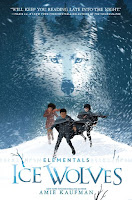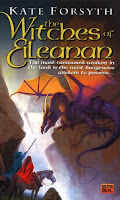I’ve been a fan of Wendy Xu’s art since I saw it one year at Small Press Expo (SPX), a mini comics conference held in the DC area each year. I was excited to pick up Wendy’s middle grade graphic novel Tidesong for the art, of course, but I was also intrigued by the incorporation of water dragons, a gorgeous color palette, and a Studio Ghibli-esque feel. Tidesong did not disappoint – it’s a charming fantasy adventure with lots of heart.
Sophie is a young witch whose mother and grandmother pressure her to attend the Royal Magic Academy—the best magic school in the realm—even though her magic is shaky at best. To train for her entrance exams, Sophie is sent to relatives she’s never met.
Cousin Sage and Great-Aunt Lan seem more interested in giving Sophie chores than in teaching her magic. Frustrated, Sophie attempts magic on her own, but the spell goes wrong, and she accidentally entangles her magic with the magic of a young water dragon named Lir.
Lir is trapped on land and can’t remember where he came from. Even so, he’s everything Sophie isn’t—beloved by Sophie’s family and skilled at magic. With his help, Sophie might just ace her entrance exams, but that means standing in the way of Lir’s attempts to regain his memories. Sophie knows what she’s doing is wrong, but without Lir’s help, can she prove herself?
Sophie is descended from a long line of witches who can control the winds and the tides, and she is determined to make her family proud, but the pressure to perform is causing some problems. First, learning the family magic is tough, and her auntie Lan is hard on her. Second, when she goes rogue and tries it on her own, she traps young dragon Lir out of his dragon form and memories. Figuring out how to untangle the mess she’s created will take patience, a change of heart, talking it out, and teamwork.
Gosh, this book was cute! It also had solid messages and themes: dealing with family expectations (meeting them, bucking them, going your own way and owning your mistakes!), wanting to learn things right away and having to adapt and slow down when it isn’t easy, and how to respond in a healthy way to intrusive negative thoughts. Sophie is young, and while she thinks she’s ready for life’s challenges, she figures out pretty quickly that she still has quite a way to go. Her aunties Lan and Sage and family friend Eugenia make for by turns stern and supportive mentors, and the family chickens are an effective spy network. If that last phrase made you chuckle, this might be the book for you! It’s got humor and heart, and while the plot is fairly simplistic (no huge plot twists here!), it is worth the read.
Of course, I mentioned dragons, and I haven’t gotten around to those yet! The first few pages of the book are a retelling of the legend of how the Wu witches got their power (wouldn’t you know, they are descended from a dragon who fell in love with a fisherman!), and this inclusion at the start of the story sets the stage for a fairy tale- and mythology-tinged tale. The illustrations tell most of the story here – there’s no extended exposition about how the magic in Sophie’s world works, no questions about different magical creatures – they just are, and they are darn cute. Tiny, fluffy chickens with teeth, a mini dragon, and a kappa all steal the show at various points as insanely adorable sidekicks. This was what felt the most like a Ghibli film to me: strange and cute sea and land creatures bobbling about on each page.
Let’s talk about that art style! Xu is well-known for her previous graphic novel Mooncakes, and you can expect the same art style in Tidesong, both a bit more refined and a bit more open-feeling, if that makes sense. The cool color palette is appropriate for the setting (the sea! the seaside! an island village!) and the variation in panel sizes, shapes, and bleed on some spreads is evocative of whatever is happening in the story. This is a graphic novel that leans more heavily on imagery than on text, and it is 100% charming.
In all, Tidesong is a magical graphic novel with brilliant (and adorable!) illustrations. A must-have for middle grade graphic novel collections.
Recommended for: fans of the animated film Ponyo and Molly Knox Ostertag’s The Witch Boy, and readers ages 7 and up.


























